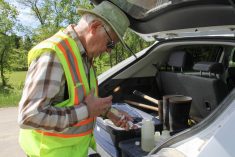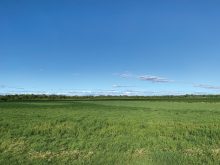Confrontational conditional use hearings may start to become a thing of the past.
Public hearings remain part of the process for reviewing any proposed large livestock operations, but by the time they’re held the public will already know what’s being proposed and will have voiced any concerns much earlier on.
Details of the new technical review process, which took effect January 1, 2012, were unveiled at the Manitoba Planning Conference here last week. Provincial officials have also met with farmers this month to discuss the changes.
Read Also

University of Manitoba honours three agriculture alumni
Cathey Day, Fred Greig and Kim McConnell were chosen for the University of Manitoba’s 2025 certificates of merit from the agricultural and food sciences faculty.
Any farmer wanting to expand a livestock operation beyond 300 animal units will still first make application for, and go through the conditional use procedures in their municipality.
What’s changed is what happens after that.
The new process enables public and government departments to review and comment on what a farmer is proposing well ahead of the conditional use hearing.
“We hope that through a more rigorous process, and by allowing the public to get involved earlier on in the process that issues of concern will get addressed before it gets to the hearing process,” said David Neufeld, director of the community and regional planning branch with Manitoba Local Government.
Producers will now document their plans in what are being called “site assessments” or SAs. These replace the former livestock production operation information forms, using a template that is downloadable online from the Manitoba Local Government link on the provincial government website. The forms will also now become available at regional Community Planning offices. Until now MAFRI GO office supplied the forms.
Assistance for producers
The SAs will ask that farmers provide more detail, said Don Malinowski, the province’s senior planner who led the development of the new review process.
But new co-ordination to help farmers is also being added to the process through the implementation of a new Technical Review Committee (TRC) co-ordinator with clerical support. The co-ordination will be provided through Community Planning.
“Our role and responsibility consists of assisting and facilitating completion of the site assessment,” said Malinowski. “Producers can call us.”
The TRC co-ordinator will also review all submitted SAs to ensure the information is complete and accurate, and will post the SA on the Manitoba Government website. The TRC co-ordinator will also see that the SA is circulated to all members of the TRC, including representatives from Agriculture, Food and Rural Initiatives, Conservation, Water Stewardship and Local Government.
Also new is the creation of an online Livestock Technical Review Public registry where the public can learn what’s being proposed, and, if they wish, register, by mail, phone, or email any concerns.
Ads will be placed in local papers notifying the public an SA is underway and will steer people to the website, said Malinowski.
All relevant and “material” public comments submitted then becomes part of the package, which together with the SA plus the TRC’s own report and recommendations, is then brought forward at the conditional use hearing.
“Off the hot seat”
These new procedures are intended to standardize a process for farmers, give them additional time to respond to any concerns raised, or for requests for additional technical information, while creating these more timely opportunities for public participation, said Malinowski.
The restructured process should also take elected local government officials “off the hot seat,” he said.
Until now, conditional use hearings have been where the public raised objections or posed questions.
“And that hasn’t always been the best scenario to be trying to answer questions and make decisions, said Malinowski.
“We wanted to change that and enable meaningful public participation somewhere else in the process.”
The new review process also aims to produce clearer and more readable TRC reports that are more understandable to all parties, including producers, local councils and members of the public. The TRC report, produced by provincial staff, will also be slimmer.
“That’s because we’re shifting a lot of the information that was generated in that report into the SA, which is what the producer is going to be providing to us,” said Malinowski.
The recommendations contained in the TRC report will also be clearer and in plainer language, in keeping with one of the recommendations of the 2007 CEC report. The TRC co-ordinator will also be present at all conditional use hearings, and potentially other designates from the TRC committee as well.
“Councils won’t be on their own,” he said. “They won’t be expected to answer technical questions. There’ll be at least one person from that committee present and possibly other members as required.”
For producers, the new technical review process means access to SAs online, access to more help from the TRC co-ordinator in preparing the documents, and having more time to respond to public concerns before the TRC report and conditional use hearing, Malinowski said.
“That’s really important because if there’s some misunderstanding, or we haven’t connected properly, we have a lot of opportunities to work things out prior to the conditional use hearing. If there are issues raised by the public the producer gets to hear about it before the conditional use hearing, and can address or make refinements or adjustments (to the SA), if necessary, to address concerns that have been raised.”
The public comment period will last 30 days from notification.
“They (the public) can expect to have material comments noted in the TRC report,” said Malinowski. However, comments must be relevant and there must be names included for documentation.
“There’s accountability here,” he said. “We’re not accepting anonymous calls.”
Producers asked for more information or clarification will have 14 days to provide additional information.
All parties will also be able to now track the progress of SAs online.
More details about the Livestock Technical Review process can be found online at www.gov.mb.ca/ia/programs/livestock/review_process.html.



















